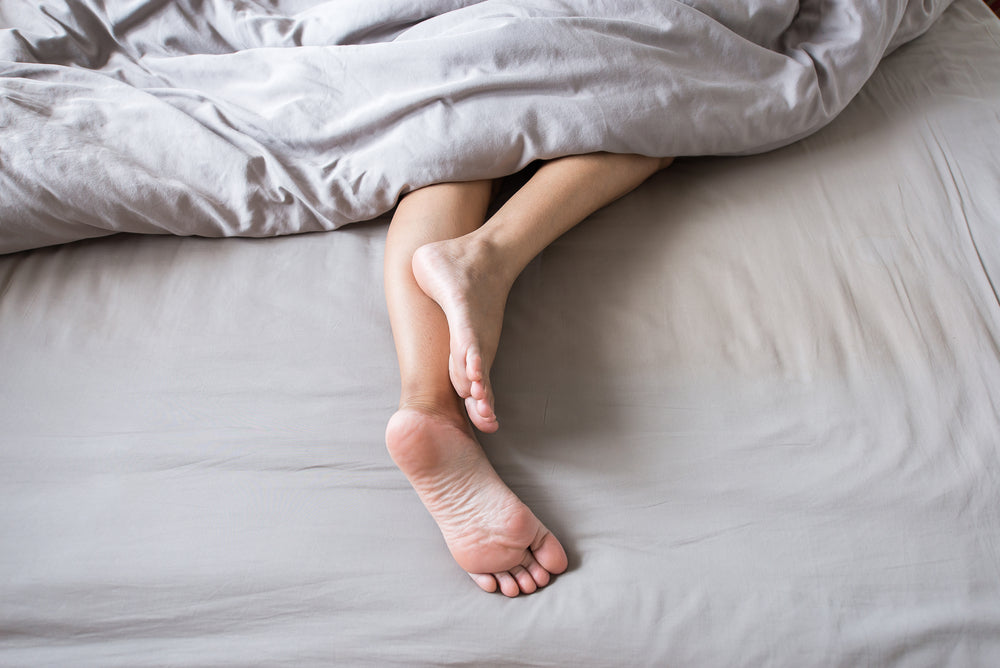With a wide range of severe symptoms, finding effective ways on how to sleep with restless legs can feel like a never-ending struggle.
This neurological disorder comes with an overwhelming urge to move our legs and is often accompanied by unpleasant sensations that include burning or itching.
In severe cases, it can even be painful and make sleeping a near-impossible task. If you're dealing with restless legs, you should know that you're not alone.
Also known as Willis-Ekbom disease, millions of people across the globe deal with this medical condition, which is why finding the right solutions is so important. That's what we'll be exploring in this article.
We'll provide you with helpful information on how to sleep better and introduce simple lifestyle changes that can help reduce the severity of restless leg syndrome symptoms.
Let's jump right in!
Best Tips for How to Sleep With Restless Legs
Dealing with restless leg syndrome can be incredibly frustrating, especially when you're trying to get a good night's rest.
But there are a few things you can do to make it easier.
Massage your legs before bed
One way to help ease the symptoms of restless legs and get a good night's rest is to massage your legs before bedtime.
A gentle, relaxing massage helps to increase circulation in your legs and reduce any uncomfortable sensations. It can also help to relieve muscle tension, which helps you feel more relaxed and ready for a good night's sleep.
Treating your legs to massage therapy can be done either by yourself or by visiting a licensed massage therapist. However, you'd probably be going to bed fairly late after getting a massage, so it might be better to do the self-massage before bed.
Self-massage tools proven to help with restless leg syndrome include a foam roller, massage gun, or leg massager. These tools can help you get rid of any knots or tension in your legs, which can help you fall asleep more easily.
Take a hot or cold bath
Taking a hot or cold bath is another great way to help you sleep better with restless legs.
While it may not be as relaxing as a massage, it can still be immensely helpful in relieving some leg discomfort associated with this condition. A warm bath helps to relax the muscles and can reduce any feelings of extremity pain or itching.
If your symptoms are particularly severe, a cold bath can also help by reducing inflammation and providing some relief. You don't have to spend a long time in the bath either.
A 10-minute soak can do wonders for mild symptoms and help you get a better night's sleep. Alternatives to taking a hot bath for restless legs include using heating pads or hot water bottles, while a cold bath can be replaced with a cold compress or ice packs.
Wear compression stockings
If the idea of wearing stockings to bed sounds like a great solution, then you'll be happy to know that compression stockings are a viable option for people with restless leg syndrome.
These specially designed socks provide light compression, which helps reduce swelling in the legs and stimulate blood flow. Wearing one to bed can also help reduce the discomfort associated with RLS.
The best part is that compression stockings are affordable and available in a variety of styles. So you'll be sure to find one that fits your needs and preferences.
Take sleeping aids
If your symptoms of restless legs are severely impacting your sleep habits, then you should consider taking a sleeping aid.
Prescription sleeping pills can help reduce the discomfort associated with RLS and make it easier to fall asleep and stay asleep throughout the night. Other natural sleep aids, such as melatonin or chamomile tea, can also be used to help you get a good night's rest.
While these sleeping aids can be helpful, you can also take prescription medications to get the relief you need. This includes medications such as dopamine agonists, benzodiazepines, and opioids.
Drink herbal tea

Drinking herbal tea is another great way to help you sleep better with restless legs.
Herbal teas contain natural ingredients that can help relax your body and mind, making it easier for you to drift off into tranquil hours of sleep. Certain herbs like chamomile, lavender, and valerian are especially effective for providing relief from unpleasant feelings associated with RLS.
You can also try adding honey or lemon to your herbal tea for added relaxation benefits. Not only does this make it tastier, but it may also help you sleep even better!
Avoid caffeine before bed
Do you often find yourself reaching for a cup of coffee or tea before bedtime?
If so, then you might be making your restless legs worse.
Caffeine is a stimulant that can interfere with your body's ability to relax and get a good night's sleep. So, try to avoid caffeine for at least 4-6 hours before bedtime in order to give your body the time it needs to relax and prepare for a restful night's sleep.
This simple step can make a world of difference in helping you find relief from your symptoms and enjoy a regular sleep schedule of 7-8 hours each night.
Don’t eat a big meal right before bed
While the thought of a big meal right before bed may sound like a great way to end the day, it can actually make your restless legs worse.
Eating a large meal right before bed will cause your body to work harder to digest the food, which could lead to increased discomfort in your legs. Try to have your last meal of the day at least 2–3 hours before you go to bed in order to give your body enough time to digest the food and reduce any restlessness in your legs.
You can also opt for smaller, lighter meals or snacks that are easier to digest if your last meal of the day is closer to bedtime.
Create a sleep-friendly environment
Creating a sleep-friendly environment can be a great way to help you get the restful sleep that you need.
This involves setting up your bedroom in such a way that it encourages relaxation and reduces distractions.
Start by making sure there's no outside noise or light coming into the room.
Invest in heavy curtains or blackout shades, an eye mask, and earplugs if necessary. What's more, make sure you have plenty of pillows and blankets to keep you warm and comfortable throughout the night.
This will ensure that you get the best sleep possible and will help to reduce any uncomfortable feeling in your legs.
These are just a few of the several different methods that you can use to help you get a better night's sleep with restless legs.
Whether you try compression stockings, sedative medications, herbal tea, or create a sleep-friendly environment, you'll be sure to find something that works for you.
Next, we'll look at some lifestyle changes you can make to help reduce the symptoms of RLS.
Making Lifestyle Changes to Improve Sleep With Restless Legs
Making a few changes to your lifestyle can be a great way to help you get better sleep with restless legs.
Here are some of the most common ones that you should consider trying:
Stretch regularly
Do you know that stretching your legs can help alleviate RLS symptoms?
Yes, you read that right.
Stretching your legs regularly throughout the day can help reduce any strong urge to move them and make it easier for you sleep well. Common stretches that can help include calf stretches, ankle circles, and hamstring raises.
Any of these daily exercises can also help promote healthy sleep habits by reducing stress and anxiety levels. Try to get at least 30 minutes of moderate exercise a day, either in the morning or afternoon.
This can help you feel more energized during the day and make it easier for you to fall asleep at night.
Be mindful of your diet

What you eat can have a big impact on your sleep quality, especially if you suffer from restless leg syndrome.
Try to avoid eating processed or sugary foods and opt for healthier choices such as fruits, vegetables, and whole grains. These food sources are rich in essential vitamins and minerals that can help provide relief from restless legs syndrome symptoms for better sleep hygiene.
Iron rich foods can be particularly beneficial, as iron deficiency anemia is a common cause of RLS. With low levels of iron, boosting your intake of foods such as dark leafy greens, red meat, beans, and fortified cereals can be helpful.
Iron supplements can also be beneficial if your iron levels are low. Talk to your doctor before taking any iron supplements, as they may not be suitable for everyone.
Avoid strenuous activities
Are you one to always stay active and take part in strenuous activities?
If so, you might want to reconsider if you suffer from restless legs. Excessive physical activity can make symptoms worse, leading to sleep disorders that become difficult to manage.
That's why it's important to find a balance between staying active and getting enough rest. Try to limit intense exercise like running or weightlifting close to bedtime and opt for activities that help you relax, such as yoga or Pilates.
Instead, focus on activities that are low-intensity, such as walking or gentle stretching, as we've already mentioned. This can help reduce restless legs at night for better sleep.
Take daily walks
Going for a daily walk can do wonders for your sleep quality.
Not only does it help you relax and relieve stress, but it can also relieve the painful symptoms of restless legs. Walking stimulates muscles in the legs and helps increase blood circulation, which can help provide relief from restless leg syndrome.
Try to take at least a 30-minute walk each day, either in the morning before work or in the evening after dinner. This can help you get better-quality sleep and ease the symptoms of RLS.
Cut out alcohol
Cutting out or limiting alcohol can also be beneficial for people who suffer from restless legs.
Alcohol is known to act as a depressant on the central nervous system and can worsen RLS symptoms. It's best to avoid drinking too close to bedtime so that it doesn't interfere with your sleep.
Alcohol can worsen the symptoms of restless leg syndrome and make it more difficult to fall asleep. As tempting as it might be to have a glass of wine or beer before bed, this is not recommended if you suffer from RLS.
Alcohol consumption can impair your sleep quality and trigger the irresistible urge to move your legs even more. Therefore, it's best to avoid it altogether if you want to get adequate sleep.
Frequently Asked Questions
Still got questions on how to sleep with restless legs?
Browse through a list of answers we receive on this topic in the section below. Feel free to let us know if you have any other questions.
What's the best sleep position for someone with restless legs?
Going to bed with restless legs syndrome can be challenging and uncomfortable, but there are certain sleep positions you can try that can help provide relief from RLS symptoms.
Many people find that sleeping on their back helps reduce the urge to move their legs. It also keeps your spine aligned, reducing any pressure points and providing relief from RLS symptoms.
What's more, sleeping on your back can help prevent snoring, which can disrupt your sleep quality. Other sleep positions that are particularly helpful include sleeping on your stomach or side with a pillow between your legs.
When should I seek medical attention to sleep better with restless legs?
While many of the tips above can help you get better sleep when you have restless legs, it's still important to seek medical attention if the symptoms persist or worsen.
If the urge to move your legs is interfering with your sleep quality or daily life and is causing distress in any way, it's best to consult your doctor. He or she may be able to diagnose the cause of your RLS and provide you with the necessary treatment.
It's important to note that people dealing with restless legs often suffer from health conditions like chronic kidney disease, rheumatoid arthritis, diabetes, and iron deficiency anaemia as well. If any of these conditions are present, it's important to seek medical attention right away.
Conclusion
Hope this article has equipped you with valuable information on how to sleep with restless legs.
Simple steps like getting a leg massage, having a warm bath before bed, and taking sleeping aids can help reduce RLS symptoms and improve your sleep quality. You can also use sleep allergy medications if your symptoms are severe.
While these tips can help you get adequate sleep with RLS, making lifestyle changes can go a long way toward reducing the symptoms. This includes stretching your leg muscles with regular exercises, avoiding alcohol, eating a healthy diet, and avoiding strenuous activities.
If, after trying these tips, you still find it difficult to sleep with RLS, it’s best to seek medical attention. Your health care provider can diagnose the cause of your RLS and provide you with an effective treatment plan based on your medical history.
Let us know if you have any other questions on how to sleep with restless legs.




